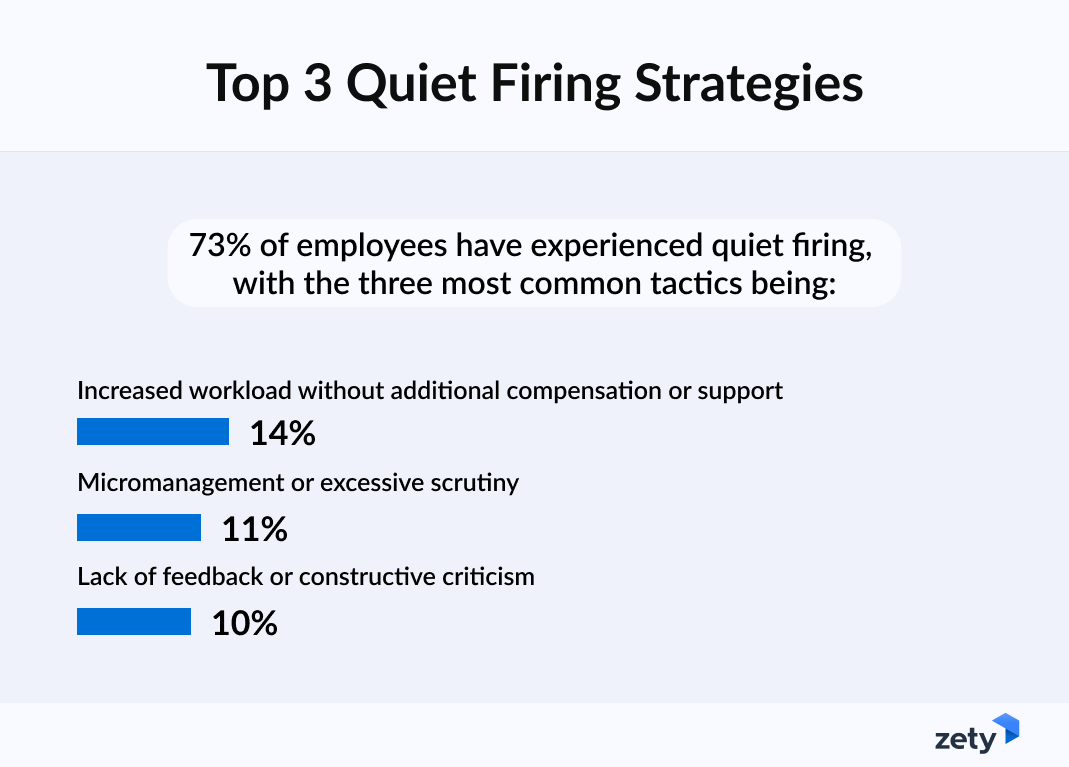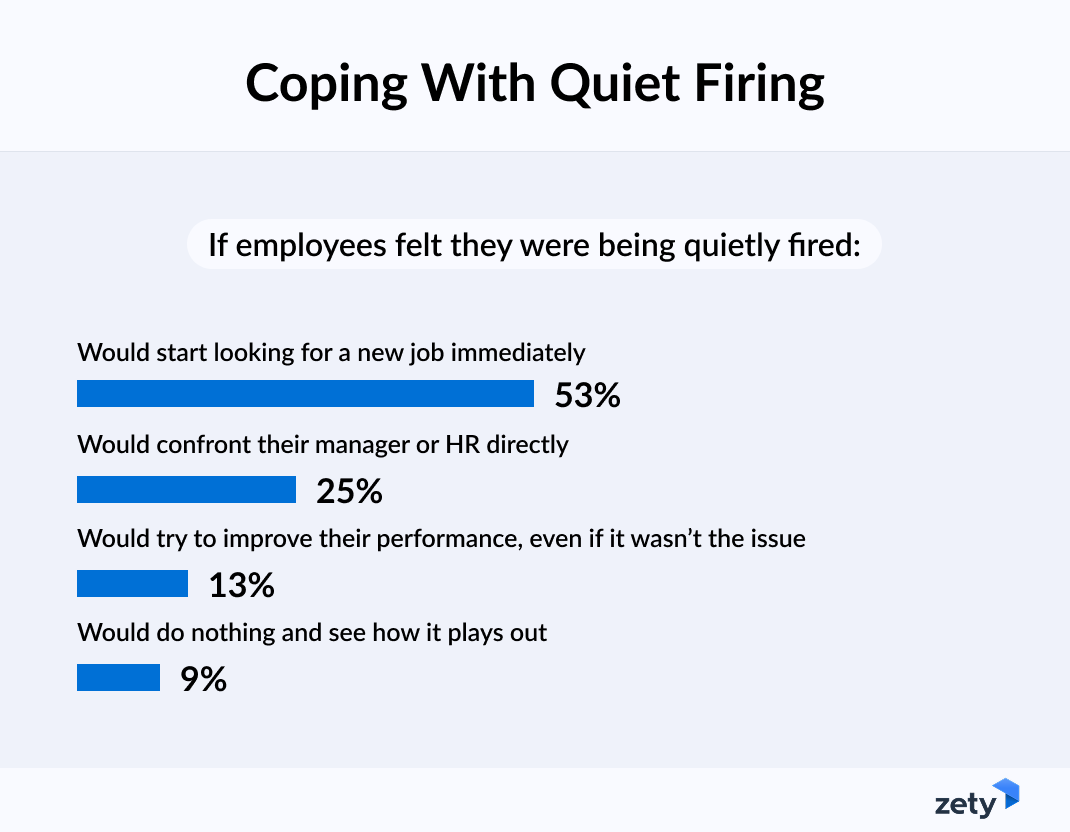
Have you ever felt like your manager was trying to get you to quit, without actually firing you? You’re not alone. According to Zety’s Quiet Firing Report, subtle pressure tactics are rapidly growing in the workplace.
The comprehensive survey of 1,000 U.S. employees found that one in four workers believe quiet firing is a very common issue today, with more than half (53%) agreeing it has become more prevalent in the last three years. The data reveals how workers are being pushed out of their roles without formal termination and how these practices are affecting workplace dynamics, employee satisfaction, and job security.
Key findings:
- RTO mandates as a quiet firing tactic: 70% believe RTO mandates are a form of quiet firing, designed to push employees out.
- Quiet firing is forcing resignations: 14% of employees have quit their job due to pressure from their employer, 17% have considered quitting, and 29% have seen a colleague pushed out this way.
- Firsthand experiences with quiet firing: The majority (73%) of employees have experienced quiet firing tactics, with the most common being increased workload without pay and excessive micromanagement.
- Fired directly versus quiet firing: 79% of employees would rather be fired outright, while 21% would prefer to be subjected to quiet firing.
- Most workers would take action against quiet firing: 53% would start looking for a new job immediately if they felt they were being quietly fired, and 25% would confront their manager or HR directly.
How Quiet Firing Is Impacting Job Seekers
Quiet firing is fundamentally changing workplace dynamics, with employees growing increasingly aware of subtle tactics used to push them out. Many are now reconsidering where they work, how they navigate job security, and what they expect from employers.
- 70% believe RTO mandates are a quiet firing tactic, designed to push employees out.
- 73% would avoid working for a company known for quiet firing practices.
- 79% of employees would rather be fired outright, while 21% would prefer to be subjected to quiet firing.
- 1 in 8 have quit their job due to pressure from their employer, and 1 in 6 have considered it.
What this means: Quiet firing is reshaping the psychological contract between employees and employers. Job seekers are no longer just vetting job descriptions but the integrity of company culture and leadership behavior.
Common Quiet Firing Tactics
The majority of employees (73%) report experiencing quiet firing strategies, which subtly diminish their role and push them toward resignation. These actions often take the form of:
- Increased workload without additional compensation or support (14%)
- Micromanagement or excessive scrutiny (11%)
- Lack of feedback or constructive criticism (10%)
- Reduced responsibilities without explanation (10%)
- Withheld promotions or advancement opportunities (9%)
- Negative performance reviews without actionable feedback (6%)
- Exclusion from key meetings or projects (5%)
- Shifted to less impactful projects (4%)
- Exclusion from social events or team activities (4%)
What this means: The normalization of these tactics reflects a shift from overt management decisions to passive-aggressive attrition—an approach that erodes trust and discourages high performance across teams.
Here is a visualization of the above data:

What Drives Quiet Firing?
Employees attribute quiet firing to several factors, many of which reflect deeper workplace challenges:
- Personality clashes with management or team members (17%)
- Cost-cutting measures or budget constraints (16%)
- Discrimination or bias (e.g., age, gender, race, etc.) (12%)
- Manager’s inability to provide constructive feedback or support (12%)
- Poor performance or underachievement (11%)
- Conflicts over work style or management expectations (11%)
- Changes in company direction, strategy, or organizational restructuring (9%)
- Misalignment with company values or culture (7%)
- Lack of career progression or stagnation in the role (5%)
What this means: These drivers reveal that quiet firing is often a coping mechanism for unresolved structural or interpersonal dysfunctions, suggesting a deeper failure in communication, inclusivity, and leadership development.
Why Employers Use Quiet Firing
Employees believe companies resort to quiet firing to avoid legal, financial, and reputational risks. The most cited reasons include:
- Avoiding legal complications (e.g., wrongful termination lawsuits) (22%)
- Reducing confrontation or conflict (22%)
- Avoiding severance pay or financial obligations (18%)
- Encouraging voluntary resignations to protect the company’s image (15%)
- Managing employees who don’t fit company culture without formal termination (12%)
- Gradually phasing out redundant roles (8%)
- Adapting to AI-driven job displacement (3%)
What this means: Employers may believe they’re minimizing liability, but by avoiding transparency, they’re fostering a culture of silence—one where fear outweighs feedback and disengagement quietly spreads.
Employee Responses to Quiet Firing
Many employees recognize the signs of quiet firing, as 30% felt they were training their replacement while being gradually pushed out of their role. Reactions to quiet firing differ, with employees taking different paths:
- 53% would start looking for a new job immediately.
- 25% would confront their manager or HR directly.
- 13% would try to improve their performance, even if it wasn’t the issue.
- 9% would do nothing and see how it plays out.
What this means: Strategic exits are becoming a survival skill, as workers prioritize long-term career health over short-term stability in toxic environments.
Here is a visualization of the above data:

Quiet firing isn’t just a management issue—it’s a wake-up call for companies to reexamine how they handle disengagement, conflict, and performance. As workers grow more attuned to subtle signs of being pushed out, organizations that lead with transparency and empathy will have the advantage.
Methodology
The findings presented were obtained by surveying 1,000 U.S. employees on February 21, 2025. Participants were queried about their experiences with quiet firing practices, responding to various question types, including yes/no questions, scale-based questions gauging agreement levels, and questions that permitted the selection of multiple options from a list of answers.

